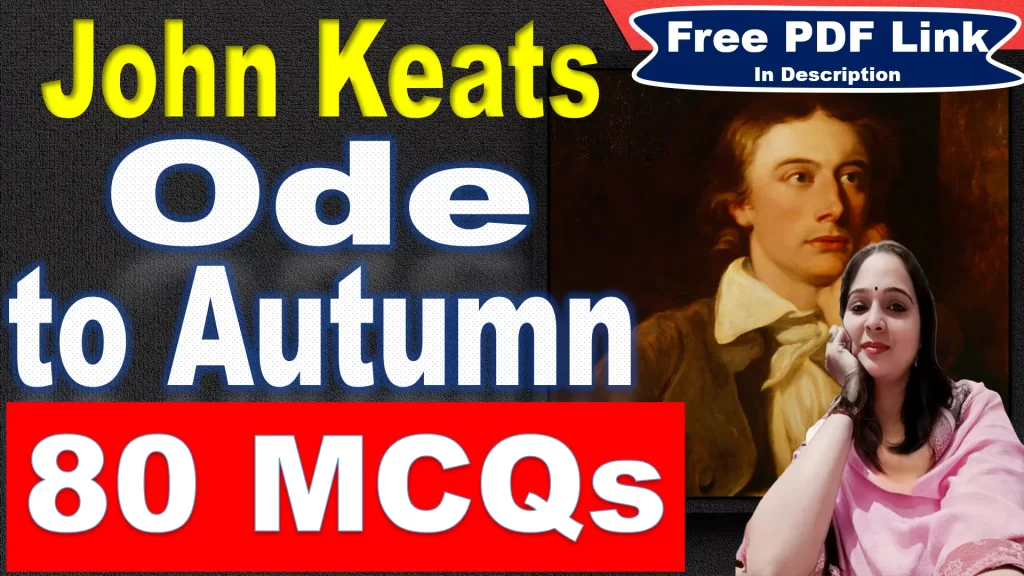
21. What is autumn metaphorically compared to in the second stanza?
A) A poet
B) A worker in the fields
C) A sleeping child
D) A wandering traveler
Answer: B) A worker in the fields
Explanation: In the second stanza, autumn is personified as a harvester or a worker who is actively engaged in the farming process. It is seen sitting on a granary floor, sleeping in a furrow, and watching the cider press. These images make autumn feel like a living being, showing that it is not just a passive season but a hardworking force that contributes to the cycle of nature.
22. What poetic device is used in “Thee sitting careless on a granary floor”?
A) Simile
B) Metaphor
C) Alliteration
D) Personification
Answer: D) Personification
Explanation: The poetic device used in “Thee sitting careless on a granary floor” from John Keats’ “Ode to Autumn” is personification.
In this line, “Thee” refers to Autumn, which is addressed directly as if it were a person capable of human actions—specifically, “sitting careless” on a granary floor. Personification occurs when a non-human entity, in this case the season of Autumn, is given human characteristics or behaviors. Throughout the second stanza, Autumn is depicted engaging in human-like activities (sitting, sleeping, watching), reinforcing this device.
A) Simile: This involves a comparison using “like” or “as,” which isn’t present here.
B) Metaphor: This is a direct comparison without “like” or “as,” but the line isn’t comparing Autumn to something else—it’s attributing human action to it.
C) Alliteration: This involves repeated consonant sounds.
D) Personification: This fits perfectly, as Autumn is portrayed as a person sitting.
23. The second stanza describes autumn as a ______.
A) Carefree observer
B) Hardworking harvester
C) Furious storm
D) Silent watcher
Answer: A) Carefree observer
Explanation: While the first stanza focuses on autumn’s productivity, the second stanza presents a more relaxed and peaceful side of the season. Autumn is described as a carefree observer, watching over the harvest, sleeping in the fields, and enjoying the sight of cider being pressed. This shows a contrast: autumn is both hardworking and calm, symbolizing the balance between effort and rest in nature.
24. What does the poet mean by “thou hast thy music too”?
A) Autumn has its own unique sounds
B) Autumn is silent and peaceful
C) The sounds of spring are still present
D) The poem is about musical composition
Answer: A) Autumn has its own unique sounds
Explanation: In the third stanza, Keats acknowledges that spring is known for its birdsong, but he reminds us that autumn has its own kind of music. Instead of chirping birds, autumn’s music includes the hum of crickets, the bleating of lambs, and the rustling of leaves. This line highlights the idea that every season has its beauty, and autumn should not be compared negatively to spring.
25. What do the “last oozings” refer to in the poem?
A) The juice extracted from apples
B) The final rays of sunlight
C) The dying flowers of autumn
D) The bees gathering nectar
Answer: A) The juice extracted from apples
Explanation: The phrase “last oozings” refers to the slow dripping of juice from apples as they are being pressed into cider. This is part of the harvesting process in autumn. The imagery of rich, flowing juice represents the final rewards of the season before winter arrives. This line contributes to the overall theme of autumn as a season of abundance and fulfillment.
26. The phrase “Soft-dying day” is an example of which literary device?
A) Simile
B) Hyperbole
C) Personification
D) Metaphor
Answer: C) Personification
Explanation: The phrase “soft-dying day” from John Keats’ “Ode to Autumn” (third stanza: “While barred clouds bloom the soft-dying day”) is an example of personification.
Here’s why: “Soft-dying” attributes a human quality—dying—to the day, which is an abstract, non-human entity. Personification occurs when something inanimate or abstract is given human characteristics or actions. In this case, the day is depicted as gently fading or passing away, much like a person might die softly, enhancing the serene mood of the autumn sunset.
A) Simile: This requires “like” or “as” for comparison (e.g., “dying like a whisper”), which isn’t present here.
B) Hyperbole: This involves exaggeration for effect (e.g., “dying a thousand deaths”), but “soft-dying” is understated, not exaggerated.
C) Personification: This fits, as the day is personified by being described as “dying” softly, a human action. D) Metaphor: This is a direct comparison without “like” or “as” (e.g., “the day is a dying flame”), but “soft-dying day” doesn’t equate the day to something else—it gives it a human trait.
27. What is the effect of the phrase “Where are the songs of spring?”
A) It mourns the loss of summer
B) It emphasizes the difference between spring and autumn
C) It predicts the coming of winter
D) It shows the poet’s sadness
Answer: B) It emphasizes the difference between spring and autumn
Explanation: This is a rhetorical question, meaning it is asked without expecting an answer. Keats is not actually sad about spring, but he uses this question to highlight how autumn has its own unique beauty. Instead of birds singing in spring, autumn has the sounds of crickets, lambs, and swallows preparing to migrate. The contrast between spring and autumn helps reinforce the theme that each season has its purpose and charm.
28. What does Keats emphasize by mentioning bees in the first stanza?
A) The decline of their population
B) Their role in pollination
C) The abundance of nectar in autumn
D) The aggression of bees in autumn
Answer: C) The abundance of nectar in autumn
Explanation: Keats describes the bees as continuing to gather nectar, thinking that summer will never end because of the rich supply of flowers in autumn. This emphasizes that autumn is still full of life and abundance, not just a season of decline. The mention of bees also reinforces the idea of nature’s cycle, where each season prepares for the next in a continuous flow of time.
29. Which of the following best describes the mood of the poem?
A) Sorrowful and nostalgic
B) Joyful and celebratory
C) Angry and rebellious
D) Fearful and anxious
Answer: B) Joyful and celebratory
Explanation: Unlike many other poems about autumn that focus on death and decay, Keats’ Ode to Autumn presents the season as rich, warm, and fulfilling. The poem describes abundant harvests, golden light, and gentle breezes, creating a joyful and celebratory mood. Instead of mourning the end of summer, the poem appreciates the beauty of autumn and highlights its role in the cycle of nature.
30. Which phrase best describes the structure of the poem?
A) Three stanzas depicting different times of the day
B) A five-stanza free verse composition
C) A single stanza reflecting on the passage of time
D) A narrative poem with a clear beginning and end
Answer: A) Three stanzas depicting different times of the day
Explanation: The poem has three stanzas, each focusing on a different part of autumn’s experience:
First stanza: Morning—describes the ripening fruits and full harvest.
Second stanza: Afternoon—autumn is personified as a relaxed observer.
Third stanza: Evening—describes the sounds and fading light of the day, hinting at the transition to winter.
31. Which of the following is NOT a feature of Keats’ poetry?
A) Sensory imagery
B) Focus on nature
C) Political criticism
D) Romantic themes
Answer: C) Political criticism
Explanation: Keats was a Romantic poet, focusing on nature, beauty, emotions, and sensory experiences. His poems are rich in imagery and personal reflection, but he did not engage in political debates or criticism like some of his contemporaries (e.g., Percy Bysshe Shelley or Lord Byron). Instead, his works celebrate timeless and universal themes such as nature’s beauty and the passage of time.
32. The word “clammy” in the poem refers to ______.
A) The dryness of autumn leaves
B) The moisture in beehives
C) The scent of flowers
D) The coldness of winter
Answer: B) The moisture in beehives
Explanation: Keats describes beehives as “clammy cells”, meaning they are moist and full of honey after a rich summer. The use of the word “clammy” gives a sensory detail, making the reader feel the thickness of honey and the humid atmosphere of the hive. This fits the theme of autumn’s abundance and fulfillment, as bees have stored food for the colder months.
33. How does Keats portray time in Ode to Autumn?
A) As an enemy
B) As a destroyer of nature
C) As a gentle and inevitable force
D) As something that can be stopped
Answer: C) As a gentle and inevitable force
Explanation: Keats presents time as natural and peaceful, rather than something to be feared. The poem does not resist change; instead, it embraces the transition from autumn to winter. The passage of time is depicted through ripening fruits, fading sunlight, and migrating birds—all natural processes that happen effortlessly. This reflects Keats’ belief that change should be accepted with grace.
34. What is the significance of the swallows in the last line?
A) They signal the coming of winter
B) They represent the poet’s loneliness
C) They are a sign of a new beginning
D) They show the beauty of nature
Answer: A) They signal the coming of winter
Explanation: The final image of the poem describes swallows gathering in the sky, preparing to migrate to warmer places before winter arrives. This serves as a gentle farewell to autumn, reminding us that each season has its time before giving way to the next. The mention of swallows is not sad, but rather a natural progression, reinforcing the poem’s theme of the continuous cycle of life and seasons.
35. What is the poet’s attitude toward autumn in the poem?
A) Regretful and nostalgic
B) Fearful and anxious
C) Appreciative and admiring
D) Indifferent and detached
Answer: C) Appreciative and admiring
Explanation: Keats does not see autumn as a sad or decaying season. Instead, he praises its beauty and abundance. He describes autumn as generous, peaceful, and fulfilling, showing deep admiration for its colors, sounds, and gifts of harvest. Unlike poets who view autumn as a time of decline, Keats celebrates its richness, making his poem unique and uplifting.
36. Which of the following is a key contrast in Ode to Autumn?
A) Summer vs. winter
B) Spring vs. autumn
C) Life vs. death
D) Youth vs. old age
Answer: B) Spring vs. autumn
Explanation: Keats compares autumn to spring, asking “Where are the songs of Spring?” but quickly reassures us that autumn has its own music—the sounds of crickets, lambs, and birds preparing for migration. This contrast highlights the differences between the two seasons, showing that each has its own beauty. While spring represents new beginnings, autumn represents completion and fulfillment, but neither is seen as superior to the other.
37. What does Keats celebrate in the poem?
A) The hardships of farmers
B) The constant change of seasons
C) The political revolutions of his time
D) The sadness of growing old
Answer: B) The constant change of seasons
Explanation: Keats does not fear change—he embraces it. The poem celebrates autumn’s beauty, but also acknowledges that it will soon give way to winter. By showing the richness of autumn, Keats reminds us that each season has its own purpose and that life is a cycle. This message applies not just to nature, but to human life as well—we should appreciate each phase instead of mourning what has passed.
38. In which year was Ode to Autumn written?
A) 1815
B) 1817
C) 1819
D) 1821
Answer: C) 1819
Explanation: John Keats wrote Ode to Autumn in September 1819. It was one of the last and most famous of his great odes, written during a highly creative period in his life.
The poem was inspired by an autumnal walk along the countryside near Winchester, England.
It was published in 1820 as part of Keats’ collection Lamia, Isabella, The Eve of St. Agnes, and Other Poems.
This period (1819) is often called Keats’ “Year of Odes,” as he also wrote other masterpieces like Ode to a Nightingale and Ode on a Grecian Urn during the same year.
Despite his short life (Keats died in 1821), Ode to Autumn remains one of the finest examples of English Romantic poetry, celebrated for its rich imagery and deep appreciation of nature.
39. Ode to Autumn was first published in which year?
A) 1820
B) 1819
C) 1821
D) 1830
Answer: A) 1820
Explanation: Keats’ Ode to Autumn was first published in 1820 as part of his collection “Lamia, Isabella, The Eve of St. Agnes, and Other Poems”. This collection contained some of his most famous works, written during what is considered his most productive year. Unfortunately, Keats was already suffering from tuberculosis at this time. The 1820 publication received praise for its sensory richness and depth, but Keats did not live long enough to see the full extent of its influence.
40. Where did John Keats write Ode to Autumn?
A) London
B) Winchester
C) Rome
D) Paris
Answer: B) Winchester
Explanation: Keats wrote Ode to Autumn while walking along the countryside in Winchester, England. The poem was inspired by the beauty of the late September landscape, filled with ripened fruits, golden fields, and the sounds of nature preparing for winter. Keats took regular walks near the River Itchen, where he closely observed the seasonal changes. This experience deeply influenced the poem, making it one of the most vivid and richly descriptive odes in English poetry.





